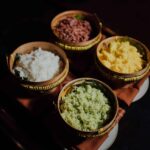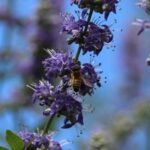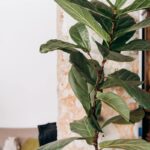Chionanthus virginicus, commonly known as the fringe tree or old man’s beard, is a small deciduous tree that belongs to the family Oleaceae. The native range of this plant spans from the southeastern United States to eastern Texas and Oklahoma. The name “fringe tree” stems from its showy, white, and fragrant flowers that appear in late spring and resemble tassels or fringes.
Fringe trees are highly valued for their ornamental features and have been popular among horticulturists for centuries. They typically grow up to 20-30 feet tall with a broad, rounded crown and gray-brown bark. In addition to their attractive appearance, they also have various medicinal properties and have been used by indigenous people for treating ailments such as fever, dysentery, and rheumatism. This article aims to provide an overview of all things related to fringe trees, including their history, cultural significance, growth habits, propagation methods, cultivation practices, and potential benefits for human health.
Origins And History Of The Fringe Tree
As a horticulturalist, I am fascinated by the chionanthus virginicus, commonly known as the fringe tree. This flowering plant is native to the southeastern United States and has a rich history dating back to the times of the Native Americans. The fringe tree was used for traditional medicine, dyeing fabrics, and even as an insecticide.
Aside from its historical significance, the fringe tree also plays a crucial role in the ecosystem. Its flowers are important sources of nectar for bees and other pollinators, while its fruits provide food for birds and small mammals. Additionally, the fringe tree’s bark has been found to have medicinal properties that can help with inflammation and pain relief.
Beyond its ecological importance, chionanthus virginicus also has economic benefits. Its wood is highly valued for its durability and resistance to decay, making it ideal for furniture and tool handles. Moreover, its ornamental value has made it a popular choice among landscapers and gardeners.
Moving forward into the subsequent section about botanical characteristics of chionanthus virginicus, it is important to note that this plant has unique features that make it stand out from other flowering trees.
Botanical Characteristics Of Chionanthus Virginicus
Chionanthus Virginicus, commonly known as the Fringe Tree, is a deciduous shrub or small tree native to the southeastern United States. It belongs to the Oleaceae family, which also includes common landscape plants like lilacs and privets. The plant can grow up to 20-30 feet tall and 15-20 feet wide, with a rounded to irregular shape.
The Fringe Tree produces fragrant white flowers in late spring to early summer, typically from May to June. These flowers are arranged in long panicles that resemble fringes or tassels, hence the name “Fringe Tree.” Flowering season may vary depending on climate conditions and location. The fruit of the plant is a dark blue drupe that matures in late summer to early fall.
The leaves of Chionanthus Virginicus are simple, opposite, and deciduous. They are elliptical or ovate-shaped with smooth margins and a shiny green surface. The leaves can grow up to 8 inches long and 4 inches wide. In autumn, they turn yellow-green before falling off the tree. Leaf morphology may vary slightly depending on the cultivar or subspecies of Chionanthus Virginicus.
The Significance Of Fringe Trees In Culture And Mythology
Fringe trees, Chionanthus virginicus, are native to the Eastern and Central United States, and are known for their attractive, fragrant white flowers which bloom in late spring. They have been an important part of religious and cultural history, with their use in folklore and symbolism. In some religious sects, fringe trees have been used to symbolize purity and innocence. In folklore, they are believed to be a symbol of luck and protection, and have been used in various forms of traditional healing. In terms of symbolism, fringe trees are seen as a representation of balance, growth and rejuvenation, and have been used to symbolize peace and harmony.
Religion
Fringe Trees, also known as Chionanthus virginicus, have significant connections and interpretations in various cultures around the world. Among these is religion, where Fringe Trees have been used as symbols and subjects of religious art and architecture.
In some Native American tribes, Fringe Trees are considered sacred and are associated with spiritual purification rituals. They believe that the tree carries healing powers that can cleanse both body and soul. In Japan, Fringe Trees are closely linked to Shintoism, where they represent purity and are often planted in temple gardens to ward off evil spirits.
Fringe Trees can also be found in various religious arts and architectures worldwide. In Christianity, it is said that the crown of thorns worn by Jesus during his crucifixion was made from a Fringe Tree. Meanwhile, in Hinduism, it is believed that Lord Vishnu rested under a Fringe Tree during his incarnation as Lord Krishna. These examples demonstrate how Fringe Trees continue to play an important role in religious beliefs and practices across different faiths.
In conclusion, the significance of Fringe Trees extends beyond its physical attributes but also encompasses cultural and mythological beliefs. Its connections to religion demonstrate how plants can hold symbolic meanings that transcend their biological functions. As such, it is essential to recognize their value not only for their aesthetic beauty but also for the cultural significance they hold in our society today.
Folklore
The cultural significance of Fringe Trees extends beyond religious beliefs and practices. It also plays a significant role in folklore, where it is believed to possess mythical properties that have been passed down from one generation to another. In some cultures, the tree is associated with good luck and prosperity, while in others, it is linked with death and mourning.
One example of Fringe Tree’s connection to folklore is its use as a divining tool. In certain African tribes, the tree’s branches are used for divination purposes, where they are tossed like dice to reveal the future. Similarly, in ancient Celtic mythology, it was believed that Fringe Trees had the power to ward off evil spirits and protect against witchcraft.
Another example of Fringe Tree’s significance in folklore is its association with fairies and other supernatural beings. In Irish folklore, for instance, it is said that fairies live inside the tree’s flowers and use them as umbrellas during rainstorms. Meanwhile, in Native American mythology, Fringe Trees are believed to be inhabited by nature spirits that can communicate with humans through dreams.
In summary, the cultural significance of Fringe Trees goes beyond religion and encompasses various aspects of folklore. Its mythical properties demonstrate how plants can hold symbolic meanings that transcend their biological functions. By recognizing its value in culture and mythology, we can gain a deeper understanding of our collective history and traditions.
Symbolism
Fringe Trees hold significant cultural and mythical value that goes beyond their physical attributes. The Fringe tree symbolism has been associated with spiritual meanings and beliefs by different cultures around the world. In some cultures, it is believed that the tree possesses mystical powers that can be used to predict the future or protect against evil spirits.
The cultural significance of Fringe Trees lies in its symbolic meanings, which vary across different communities. For instance, in Chinese culture, the tree symbolizes youth and feminine beauty due to its delicate white flowers. In contrast, Native American mythology associates Fringe Trees with death and mourning since the tree blooms during funerals. Similarly, African tribes believe that Fringe Trees represent fertility and prosperity since they are used as a source of medicine and food.
The spiritual meanings attached to Fringe Trees further demonstrate their cultural importance. For example, in Christianity, the tree is believed to represent resurrection due to its ability to bloom even after being cut down severely. Meanwhile, in Hinduism, Fringe Trees are considered sacred plants that bring blessings and good fortune to those who grow them. These various symbolic meanings reveal how Fringe Trees have played a vital role in shaping our cultural beliefs and practices throughout history.
Growing Requirements And Environmental Preferences
Fringe trees, also known as Chionanthus virginicus, are highly valued for their ornamental appeal and cultural significance. However, to ensure the healthy growth of these trees, it is important to understand their growing requirements and environmental preferences.
Soil conditions play a critical role in the overall well-being of fringe trees. They thrive in well-draining soils that are slightly acidic to neutral in nature. These trees prefer moist but not waterlogged soils, which means that overwatering can lead to root rot and other fungal diseases. It is recommended to check the soil moisture level frequently and water only when necessary.
Watering frequency is another important aspect of caring for fringe trees. During the growing season, they require regular watering to maintain healthy foliage and flower production. However, it is essential not to overwater these trees as this can lead to root damage and ultimately death. It is best to wait until the top inch of soil feels dry before watering again.
Understanding soil conditions and watering frequency are crucial elements in maintaining the health of fringe trees. By providing optimal growing conditions, they can flourish and provide beauty for many years to come. In the following section, we will discuss propagation techniques for fringe trees so that you may expand your collection or share them with others who appreciate their unique qualities.
Propagation Techniques For Fringe Trees
Fringe trees or Chionanthus virginicus can be propagated through cutting or grafting techniques. Cutting propagation is a common method where a plant stem with a few leaves is removed from the parent plant and rooted in soil. It is important to choose healthy, disease-free stems and to ensure that the cuttings are taken during the dormant season. A rooting hormone may also be applied to increase the chances of success.
Grafting is another propagation technique that involves joining two different plants together to create a new hybrid plant. The rootstock, which provides the root system, is chosen for its strong and vigorous growth while the scion, which provides the desired characteristics of the plant, is carefully selected. Grafting should only be done by experienced horticulturists as it requires precise cuts and careful handling to ensure successful growth.
When propagating fringe trees, it is important to note that they generally have a slow growth rate and may take several years before becoming established. Therefore, patience and attention to detail are essential for successful propagation.
Next up: Cultivation Practices and Maintenance Tips…
Cultivation Practices And Maintenance Tips
As a highly valued ornamental tree, the cultivation of fringe trees requires careful attention to detail. One essential factor in successful growth is proper soil preparation. Fringe trees thrive in well-draining soils that are rich in organic matter. Gardeners should take care to provide adequate nutrients and moisture for optimal growth. Before planting, it is advisable to conduct a soil test to determine if any amendments are necessary.
Regular pruning is also crucial for maintaining healthy and aesthetically pleasing fringe trees. Pruning techniques will depend on the specific cultivar and desired shape of the tree. Generally, young trees require more frequent pruning than mature specimens. Dead or diseased branches should be removed promptly, as well as any crossing branches that could damage the tree’s structure.
In addition to providing adequate soil and regular pruning, gardeners must remain vigilant against common pests and diseases that can afflict fringe trees. These may include fungal infections such as powdery mildew or leaf spot, as well as insect pests like scale or spider mites. Early detection and intervention are key to preventing serious damage to the tree’s health and appearance. By following these cultivation practices and maintenance tips, gardeners can enjoy healthy and beautiful fringe trees for years to come. In the subsequent section, we will discuss common pests and diseases of fringe trees that gardeners should be aware of for effective management strategies.
Common Pests And Diseases Of Fringe Trees
Fringe trees are susceptible to leaf spots, which are caused by a variety of fungi. These spots are typically round and may have a red, yellow, or brown coloration. Scale insects are another common pest of fringe trees, which can cause leaf discoloration and stunt growth. To prevent the spread of these pests, it is important to assess the tree regularly and prune away infected parts.
Leaf Spots
Fringe tree leaf spots are one of the commonly encountered problems by gardeners and landscapers alike. This condition is characterized by the appearance of circular or irregular-shaped patches on the leaves, which may vary in color from yellow to brown. The causes of these leaf spots can be attributed to various factors such as fungal or bacterial infections, environmental stressors, or insect infestation.
Treatment for fringe tree leaf spots usually depends on the underlying cause. For fungal or bacterial infections, applying fungicides or bactericides may be necessary. Insecticides may also be needed to control pests that cause damage to the leaves. However, prevention is always better than cure. Proper cultural practices such as providing adequate irrigation and fertilization, pruning diseased branches, and ensuring proper air circulation can go a long way in preventing leaf spot infections.
Preventing fringe tree leaf spots requires a combination of strategies and tips that promote plant health and reduce stress factors. First, avoid overhead watering which can lead to moisture accumulation on leaves, providing a conducive environment for fungal growth. Second, maintain good hygiene by removing fallen leaves and debris around the tree’s base area regularly. Thirdly, planting resistant cultivars that are less susceptible to diseases can also help in reducing incidence rates of fringe tree leaf spots. By implementing these measures effectively, one can keep their fringe trees healthy and attractive all year round.
Scale Insects
Another common problem that affects the health and appearance of fringe trees is scale insects. These pests are small, sap-sucking insects that attach themselves to the tree’s branches and leaves, causing yellowing or wilting. They have a protective shell that shields them from predators and environmental factors, making them difficult to control.
Scale insects have a complex life cycle that involves several stages, including egg, nymph, and adult. The adult females lay eggs under their protective shell, which hatch into crawlers that move to other parts of the tree. Once they find a suitable spot, they settle down and begin feeding on the plant’s sap. As they grow, they secrete a waxy substance that covers their bodies and forms a protective shell.
To control scale insects effectively, it is essential to identify the infestation early and take appropriate measures promptly. One way to do this is by inspecting the tree regularly for signs of damage or discoloration. Removing heavily infested branches or leaves manually can also help in reducing population size. Additionally, applying horticultural oils or insecticidal soaps can be effective in controlling scale insects without harming beneficial insects such as bees or butterflies.
In conclusion, preventing common pests and diseases of fringe trees requires good cultural practices such as regular inspection and maintenance of plants. Control methods for scale insects include physical removal of infested parts and application of horticultural oils or insecticidal soaps. By incorporating these strategies into your gardening routine, you can keep your fringe trees healthy and beautiful all year round.
Medicinal Properties And Traditional Uses
Chionanthus virginicus, commonly known as the fringe tree, has been used for medicinal purposes in traditional medicine for centuries. The bark, leaves, and roots of the tree have been utilized by indigenous people to treat a multitude of ailments such as inflammation, fever, liver disorders, and rheumatism. Traditional preparations include teas made from the leaves or bark or poultices made from the root.
Clinical studies have also shown promising results in exploring the potential health benefits of Chionanthus virginicus. Research suggests that the plant extract may possess anti-inflammatory and antioxidant properties that could be beneficial in treating conditions such as arthritis and cardiovascular disease. Additionally, it has been found to exhibit antitumor activity against cancer cells.
Through its rich history of traditional use and modern scientific research, Chionanthus virginicus continues to hold promise as a medicinal plant with potential benefits for human health. Its diverse range of uses makes it an important botanical resource that deserves further exploration and study.
As we delve deeper into understanding the properties of this remarkable plant, we can unlock its full potential in aiding our efforts towards serving others through natural means. In the next section, we will explore some potential benefits for human health that may make Chionanthus virginicus a valuable addition to our wellness regimens.
Potential Benefits For Human Health
As we delve deeper into the world of plants, we discover that they hold a wealth of phytochemicals with potential benefits for human health. The fringe tree or chionanthus virginicus is one such plant that has been explored for its medicinal properties. Phytochemicals found in this plant include flavonoids, iridoid glycosides, and terpenoids, which have shown anti-inflammatory, antispasmodic, and antihypertensive effects.
The clinical applications of the fringe tree have been studied extensively. One of its most notable uses is in the treatment of eye infections caused by bacteria and viruses. It has also been used as a liver tonic and to treat liver diseases such as hepatitis. Additionally, research suggests that it may be effective in reducing inflammation associated with rheumatoid arthritis.
While the potential benefits of the fringe tree are promising, further research is needed to fully understand its mechanisms of action and efficacy. In order to conserve this valuable plant species for future generations, efforts must be made to protect its natural habitat and promote sustainable harvesting practices. As we continue to explore the potential applications of phytochemicals found in plants like the fringe tree, it is important that we also prioritize their preservation for future research and conservation efforts.
Future Research And Conservation Efforts
Chionanthus virginicus, commonly known as the fringe tree, is a small deciduous tree that is native to the Southeastern United States. Its attractive white, fragrant flowers make it a popular ornamental plant in gardens and landscapes. While there have been some studies on the potential health benefits of fringe tree, more research is needed to fully understand its medicinal properties.
Conservation strategies for fringe tree should focus on protecting its natural habitat and ensuring its survival in the wild. This can include efforts to reduce habitat loss due to deforestation and urbanization, as well as initiatives to prevent the spread of invasive species that can compete with fringe tree for resources. In addition, fostering partnerships between government agencies, conservation organizations, and private landowners can help create protected areas where fringe trees can thrive.
Research opportunities related to fringe tree are vast and varied, ranging from studies on its ecological role in forest ecosystems to investigations into its potential medicinal uses. Scientists could explore the chemical compounds present in various parts of the plant, such as leaves and bark, to determine their therapeutic value. Additionally, genetic studies could shed light on the evolutionary history of this unique species and help inform future conservation efforts.
- Explore local gardens or nurseries that carry Chionanthus virginicus for planting in your own yard.
- Volunteer for local conservation organizations that work towards protecting native plant species like the fringe tree.
- Attend lectures or conferences led by botanists or horticulturalists who specialize in studying this fascinating species.
- Support scientific research by donating funds to universities or institutions conducting research projects related to Chionanthus virginicus.
In summary, while we know some about the potential health benefits of Chionanthus virginicus, there is still much we do not understand about this unique species. Conservation strategies should focus on protecting its natural habitat and promoting partnerships among conservation organizations and private landowners. Meanwhile, ongoing research opportunities offer exciting possibilities for learning more about the ecological and medicinal properties of the fringe tree.
Conclusion
Chionanthus Virginicus, commonly known as the Fringe Tree, is a captivating and unique species that has been celebrated for its remarkable beauty and medicinal properties. Its origins can be traced back to the southeastern United States, where it has long been cherished by Native American cultures for its medicinal uses. With its distinctive appearance and cultural significance, the Fringe Tree has become a beloved plant in gardens and landscapes across the world.
The Fringe Tree is renowned for its delicate white flowers that resemble fringes or tassels, which appear in late spring or early summer. While it is primarily grown for ornamental purposes, it also possesses numerous health benefits and has been used traditionally to treat various ailments such as fever, rheumatism, and liver disorders. Despite being a hardy plant with few pests or diseases, conservation efforts are necessary to preserve this valuable resource.
In conclusion, Chionanthus Virginicus is a remarkable species with distinctive characteristics that make it an excellent addition to any garden or landscape. Its rich cultural history and traditional uses make it an important part of our natural heritage. As botanists and horticulturalists, we must continue to study this fascinating plant and work towards conserving its genetic diversity to ensure its survival for future generations. The Fringe Tree serves as a reminder of the beauty and importance of our natural world.
Image Credits
- “Fringe Tree Frog (Cruziohyla craspedopus)” by Seánín Óg (featured)





























